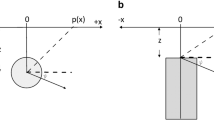We present a polarimetric approach that can be used to characterize subsurface targets by means of ground-penetrating radar. Several quantities related to the Huynen-fork parameters are basic to the study. These quantities are all expressible in terms of the elements of Sinclair matrix S which in turn, can be determined as functions of frequency by an application of the method-of-moment (MoM)—which is briefly reviewed here—to a mine-like object buried at various depths in a soil of specified dielectric and moisture properties. The quantities in question are the Stokes parameters, the elevation, azimuth, and polarizability angles, as well as the polarization ratios and the scattering eigenvalues which optimize the backscattered power. Some of these quantities are studied here and displayed in various graphs. These frequency dependent graphs exhibit useful symmetry properties. The plots of the polarizability angle (β) vs. frequency seem to remain invariant with target depth, and exhibit resonance features that are later shown to agree well with other standard methods to estimate resonances such as Prony method. A simple analysis of the early-time resonances thus estimated is used to obtain acceptable mine dimensions. The agreement found implies that polarimetric techniques, such as present one, can also be used in the arsenal of techniques yielding target-ID clues.
Similar content being viewed by others
References
Taylor J.D. (1995). Introduction to Ultra-wideband Radar System. CRC Press, Inc, Boca Raton, FL
Huynen, J.R., 1970, Phenomenological Theory of Radar Targets, Ph.D. Dissertation, Technical University, Delft, The Netherlands. Also, article of the same title in Electromagnetic. Scattering, Ch. 11: Uslenghi, P.L.E. ed. Academic Press, N.Y. p. 653–712, 1987.
Mandel, L. and Wolf, E., 1995, Optical Coherence and Quantum Optics Cambridge University Press, p. 348–358
Harrington R.F. (1968). Field Computation by Moment Methods. Macmillan Co., NY
Prony’, R., 1795, Essai expérimental et analytique sur les lois de la dilatabilité de fluides élastiques et sur celles de la force expansive de la vapeur de l’alkool, à différentes températures: Journal de l’École Polytechnique, Floréal et Plairial, an III V. 1, p. 24–76.
Mott H. (1992). Antennas for Radar and Communications: A Polarimetric Approach. J. Wiley and Sons, Inc., N.Y
Brosseau C. (1998). Fundamentals of Polarized Light: A Statistical Optics Approach Ch. 4. J. Wiley and Sons Inc., N.Y
Boerner, W.M. and Xi, A.Q. 1990, The characteristic radar target polarization state theory for the coherent monostatic and reciprocal case using the generalized polarization transformation ratio formulation: Archiv der Elektrischen Ubertragung, V. 44, no. 6.
Boerner W.M., El-Arini M.B., Chan C.Y., and Mastoris P.M. (1981). Polarization dependence in electromagnetic inverse problems. IEEE Trans. Anten. Propagat., AP-29 2:262–271
Boerner W.M. (1980). Polarization utilization in electromagnetic inverse scattering, Ch 7. In: Baltes HP. (eds). Inverse Scattering Problems. Springer, Berlin
Born M., and Wolf E. (1964). Principles of Optics: 2nd ed. Pergamon Press, N.Y
Huynen J.R. (1990). The Stokes matrix parameters and their interpretations in terms of physical target properties: SPIE v. 1317:195–207
Ulaby F.T. and Elachi C. (eds) (1990) Radar polarimetry for Geoscience Applications. Artech House, Inc., Norwood, MA
Sadjadi, F.A., Chun, C.S.L., Sullivan, A., and Gaunaurd, G.C., 2005, Buried object characterization via GPR and Huynen’s polarimetric parameters: Opti. Eng. v. 44, no. 12, p.1262001-1–1262001-15.
Au Kong J. (2000). Electromagnetic Wave Theory. EMW Publishing, Cambridge, MA, p. 280 & 651.
Geng, N. and Carin, L., 1999, Wideband electromagnetic scattering from a dielectric body of revolution buried in a layered lossy, dispersive medium: IEEE Trans. Anten. Propagat., AP-47, p. 610–619.
Mittra R. (1976). Integral equation methods for transient scattering. In: Felsen L.B. (eds) Transient Electromagnetic Fields. Springer-Verlag, Berlin
Michalski K.A., and Zheng, D., 1990, Electromagnetic scattering and radiation by surfaces of arbitrary shape in layered media, Part I: Theory, Part II: Implementation and results for contiguous half-spaces, IEEE Trans. Anten. Propagat. AP-38, no. 3, p. 335–352.
Snyder, J.P., 1987, Map Projections-A Working Manual U.S. Geological Survey Professional Paper, 1385, U.S. Government Printing Office, Washington, DC (1987).
Van Blaricum, M.L., and Mittra, R., 1975, A technique for extracting the poles and residues of a system directly from its transient response: IEEE Trans. Anten. Propagati., AP-23, no. 11, p. 777–781
Wang Y. and Shuley N. (2000). Complex resonant frequencies for the identification of simple objects in free-space and lossy environments. Prog. Electromagnet. Res., PIER 27:1–18
Chan L.C., Moffatt D., and Peters L. Jr. (1979). A characterization of subsurface radar targets. Proc IEEE 67(7):991–1000
MATLAB Prony function, 2002, MATLAB Help Notes, Version 6.5, Release 13. See also Singh, S., 2003, Application of Prony analysis to characterize pulsed corona reactor measurements, M.S. Thesis, EE Department, University of Wyoming.
Author information
Authors and Affiliations
Corresponding author
Rights and permissions
About this article
Cite this article
Sadjadi, F.A., Chun, C.S.L., Sullivan, A. et al. The Huynen-Fork Polarization Parameters in the Classification of Dielectric Mine-like Objects. Subsurf Sens Technol Appl 7, 23–44 (2006). https://doi.org/10.1007/s11220-006-0022-7
Published:
Issue Date:
DOI: https://doi.org/10.1007/s11220-006-0022-7




